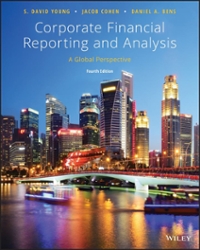Question
Required:For each of the below independent situation, determine whether or not control exists and, if so, by which party.Discuss the reasons for your answers.Where possible,
Required:For each of the below independent situation, determine whether or not control exists and, if so, by which party.Discuss the reasons for your answers.Where possible, support your answer with excerpts from AASB 10.
You will be marked based on the explanation of your answer and not the Standard's wordings itself.
The following are independent situations:
a) 503 Ltd, a supplier of sailing equipment, was incorporated 10 years ago and is 60 per cent owned by 305 Group.503 Ltd has been a very successful business, averaging annual profits of $500 000.However, during the past two years the company has run into financial difficulties and has defaulted on its loan with its bank.Consequently, the bank has used the powers in the load agreement to monitor the company's activities closely in order to obtain repayment of its debt.The company must now obtain the bank's authorisation for any expenditure over $5 000 and no changes in operations of the company are permitted without the bank's approval.
Page | 5
b) GK Pty Ltd is a family-run book publisher that has purposely refrained from using high-technology equipment over the past five years as the directors (the G family) considered it to be a 'fad' and a waste of the company's resources.As a result, the company's antiquated equipment has failed to produce quality material and has been very inefficient compared with GK's competitors.During the current year, the company's bankers took possession of the company's assets, converted all the debt into equity and two directors of the bank were appointed to GK's board, which now totals four people.The bank is undecided whether it should sell the company's assets, which have little recoverable value, or reject further equity into the company, purchase more advanced equipment and attempt to trade on and sell the business as a going concern.
c) ACT Ltd is a 30 per cent shareholder of Investment Co. Pty Ltd.The other shareholders have smaller shareholdings (approximately 8 to 12 per cent) and are always too busy to attend annual general meetings.ACT has two non-executive seats on the board and the remaining three are held by other shareholders - one chief executive officer who is a shareholder and two non-executives -who do make an attempt to attend board meetings
d) SA Ltd is owned 50 per cent by B1 Ltd and 50 per cent by B2 Ltd (the founding shareholders).Each has two seats on the board, with no party having a casting vote, although B1 Ltd appoints the managing director.Profits are split 50-50 after the provision of the managing director's salary.B2 Ltd has agreed that it will pay a management fee to B1 Ltd, equivalent to 50 per cent of the results for the year, in the event of a loss.B1 Ltd is a holder of 10 options, which are exercisable at any time at a 10 per cent discount to the fair value of the shares as at the exercise date.
e)B Juice Ltd is a 51 per cent shareholder in ChatTea Ltd and currently has two out of five board seats.Tram Ltd holds the remaining 49 per cent shares and currently has the other three seats.B Juice Ltd is a passive shareholder as it is happy with the way Trampoline Ltd has been running the company.
f) PS Ltd, GS Ltd and HS Ltd are each 33.33 per cent shareholders of PGH Pty Ltd, a small proprietary company that is involved in the music industry.PS Ltd and HS Ltd are passive shareholders with the one board seat each out of a total of three. GS Ltd has one board seat and is also involved in the day-to-day running of the business.
Step by Step Solution
There are 3 Steps involved in it
Step: 1

Get Instant Access to Expert-Tailored Solutions
See step-by-step solutions with expert insights and AI powered tools for academic success
Step: 2

Step: 3

Ace Your Homework with AI
Get the answers you need in no time with our AI-driven, step-by-step assistance
Get Started


